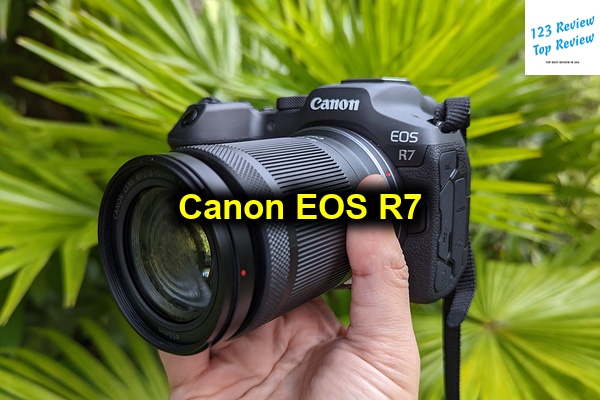Canon continues to expand its mirrorless camera lineup, and the Canon EOS R7 represents a robust addition aimed primarily at enthusiasts and semi-professionals. Nestled in the APS-C segment, the R7 offers a balance of features that highlight impressive image quality, superior autofocus systems, and comprehensive video capabilities.

In this article, 123 Review delves into the design, performance, usability, and all the fine points that make the EOS R7 a compelling choice for those seeking superior flexibility and performance.
Design and Build Quality
Weight and Dimensions
The Canon EOS R7 shines with its compact yet sturdy build, facilitating easy handling and portability. Weighing in at just under 612 grams (approximately 1.35 pounds) with battery and card, the camera is lightweight enough for everyday use and extended shooting sessions. Its dimensions—132.0 x 90.4 x 90.3 mm (5.20 x 3.56 x 3.55 in)—ensure it fits conveniently into most camera bags, making it an ideal choice for travel photographers or event shooters who need to be mobile yet prepared.
This lightweight and compact design doesn’t mean compromising on the ergonomics or functionality that photographers expect from a Canon product. The form factor is meticulously crafted to ensure an advantageous mix of portability without sacrificing feature richness or performance.
Ergonomics and Control Layout
Ergonomically, the Canon EOS R7 is crafted to provide a comfortable shooting experience. The grip is deep and well-contoured, enabling a secure hold even while using heavier lenses. This design choice helps photographers maintain balance and stability, reducing fatigue during extensive shoots.
The control layout of the R7 is logical and intuitive. Essential buttons and dials are within easy reach, allowing for quick adjustments without diverting attention from the viewfinder. The R7 features a control wheel that’s seamlessly integrated into its design, offering tactile feedback for setting changes. Additionally, the multi-controller and quick control dial are ergonomically placed to ensure that frequent settings can be modified rapidly and with ease, enhancing user experience during complex shooting scenarios.
Weather Sealing and Durability
An important aspect of the Canon EOS R7 is its robust construction, underscored by effective weather sealing. This attribute confers a layer of protection against dust and moisture—a crucial characteristic for outdoor photographers who may encounter unpredictable weather conditions. The use of resilient materials reinforces the structural integrity of the camera body, making the R7 tough enough to handle the bumps and challenges of diverse shooting environments.
The durability extends to its exterior finish, which can handle scratches and minor impacts, promising photographers a reliable tool that withstands the test of time and the elements.
Image Quality
Sensor Performance
The Canon EOS R7 is equipped with a 32.5-megapixel APS-C CMOS sensor, marking a significant leap in resolution that positions it favorably within its class. This sensor allows for incredibly detailed images with vibrant colors and sharp clarity, whether shooting landscapes, portraits, or wildlife.
Harnessing the power of the DIGIC X image processor, the sensor offers improved readout speeds, enhancing both still and video performance. The synergy between the sensor and processor results in faster image capture, refined processing capabilities, and an ability to handle high-speed continuous shooting efficiently, all while maintaining exceptional image quality.
Dynamic Range and Color Rendition
The dynamic range of the EOS R7 is noteworthy, providing photographers with the ability to capture a broad spectrum of tones. This is especially beneficial in high-contrast scenes where retaining detail in both shadows and highlights is critical. Coupled with Canon’s celebrated color science, the R7 produces images with rich, natural colors that require minimal post-processing.
Color rendition is both accurate and appealing, making this camera an excellent choice for professionals who prioritize true-to-life color reproduction. The R7 handles various lighting conditions adeptly, allowing users to shoot confidently without worrying about losing detail or compromising on image quality.
Noise Levels and ISO Performance
When it comes to ISO performance, the Canon EOS R7 excels, offering a native ISO range of 100–32000, expandable to 51200. This range provides photographers with flexibility in diverse lighting conditions, maintaining impressive image clarity even at higher sensitivity settings.
Noise levels are well-handled, and the DIGIC X processor plays a pivotal role in noise reduction, ensuring images retain fine detail and texture without the loss of quality that often accompanies high ISO settings. This capability makes the R7 a reliable companion for low-light photography, be it at events, capturing cityscapes at night, or exploring the natural world after dark.
Autofocus System
Autofocus Modes and Features
The Canon EOS R7’s autofocus system is a standout feature, using Dual Pixel CMOS AF II technology to deliver quick and accurate focusing. With up to 5,915 selectable AF positions, the camera allows photographers unparalleled control over focus point placement. The AF system is sophisticated, supporting numerous modes, including Spot AF, One-shot AF, and Servo AF, to address different shooting scenarios efficiently.
One of the most impressive facets of the R7 is its eye, face, and animal detection capabilities, ensuring subjects are captured with precision. This automated detection works in tandem with its subject tracking, reinforcing Canon’s prowess in creating cameras that excel in diverse and demanding shooting conditions.
Subject Tracking Performance
Subject tracking is integral to the R7’s advanced AF system, offering exceptional performance even when following fast-moving subjects. It can lock onto a subject and maintain focus reliably, proving invaluable for sports and wildlife photography where unpredictability and rapid movement define every moment.
This tracking system utilizes AI to predict subject movement, resulting in improved accuracy. The R7’s ability to retain focus on a moving subject across the frame provides photographers with confidence, enhancing their ability to capture fleeting moments as they unfold naturally.
Low Light Autofocus Capabilities
In low-light environments, the autofocus capability of the EOS R7 maintains its proficiency, able to perform down to an impressive EV -5. This ability to focus in minimal light conditions ensures users can continue to shoot effectively even when natural light fades, or when artificial lighting is scant.
This performance is crucial for photographers who frequently work in challenging lighting, such as event or street photographers, broadening their creative options without being hampered by limitations in AF reliability.
Burst Shooting and Buffer Performance
Mechanical and Electronic Shutter Speeds
The Canon EOS R7 supports both mechanical and electronic shutter options, providing versatility to photographers based on their needs. The mechanical shutter supports speeds of up to 1/8000 second, while the electronic shutter allows for speeds up to 1/16000 second. This flexibility is instrumental when capturing fast-paced action or when shooting in bright conditions where reduced exposure time is beneficial.
Both shutter options function smoothly, minimizing rolling shutter effects while delivering consistent results in high-speed scenarios, making the R7 a suitable choice for sports photographers and those capturing dynamic action.
Continuous Shooting Frame Rates
With a continuous shooting rate of up to 15 fps using the mechanical shutter and an impressive 30 fps with the electronic shutter, the EOS R7 is adept at capturing rapid sequences. This feature is invaluable for photographers who need to catch multiple images in quick succession, ensuring that critical moments are never missed.
The fast frame rates of the R7 cater to diverse photography needs, from wildlife to high-speed sports, providing ample opportunities to choose the best shot from a burst sequence. This capability highlights the R7’s potential in capturing the essence of fleeting movements with precision.
Buffer Capacity and Clearance Times
The buffer performance of the Canon EOS R7 complements its burst shooting prowess. It can handle approximately 50 RAW images and hundreds of JPEGs in a single burst, reducing the risk of slowing down during continuous shooting. This capacity ensures that photographers do not miss a shot because the buffer is full.
Additionally, the swift clearance times enable the camera to return to full operational speed quickly, sustaining the overall pace of shooting, which is particularly crucial in fast-paced environments. This efficient buffer system makes the R7 a reliable tool for photographers in need of robust performance without downtime interruptions.
Video Capabilities
Video Resolution and Frame Rates
The Canon EOS R7 is equipped with impressive video recording capabilities. It offers 4K recording at up to 60fps, using the full width of the sensor for high-quality footage. The ability to shoot in full-resolution 4K allows for exceptional detail and clarity, suitable for both professional work and personal projects.
In addition to 4K, the R7 supports Full HD recording at up to 120fps, providing options for creating smooth slow-motion videos. This versatility in video resolution and frame rates makes the R7 an attractive option for videographers looking to explore diverse storytelling techniques.
In-Body Image Stabilization for Video
The inclusion of in-body image stabilization (IBIS) in the Canon EOS R7 significantly enhances video recording stability, providing compensation for camera shake across five axes. This feature is particularly beneficial when shooting handheld, allowing for smooth footage without the need for additional stabilization equipment.
Coupled with digital IS for video, the R7 can achieve even greater stability, making it an excellent choice for run-and-gun shooting styles or capturing footage in challenging environments. This capability ensures videographers can produce high-quality, shake-free videos across various conditions and scenarios.
Codec and Format Options
The EOS R7 offers a range of codec and format options tailored for different user needs. It supports H.264 and H.265 formats, providing flexibility in both recording quality and file size considerations. The availability of 10-bit recording, with Canon Log 3, adds depth to the footage, allowing for extensive color grading and cinematic flexibility during post-production.
These features cater to professional creators seeking a camera that provides both easy-to-use formats for quick projects and detailed files that maximize post-processing potential, thus broadening the appeal of the R7 to a wide spectrum of video content creators.
Comparisons with Other Models
Canon EOS R vs. EOS R7
When juxtaposing the Canon EOS R7 against the EOS R, various distinctions emerge. The EOS R takes precedence with its full-frame sensor, ideal for photographers covering landscapes, portraits, and studio work due to its extensive field of view and improved bokeh.
Conversely, the APC-C sensor in the R7 maximizes reach and rapid frame rates, making it more suited for wildlife, sports, and action photography. The advanced autofocus and video capabilities of the R7 also make it preferable for dynamic content and versatility for creators pivoting between photography and videography.
Comparison with Fujifilm and Sony APS-C Cameras
In the realm of APS-C cameras, the Canon EOS R7 competes head-to-head with models from Fujifilm’s X-series and Sony’s Alpha series. Fujifilm offerings like the X-T4 are known for excellent color science and build quality but often lag slightly behind Canon in autofocus advancements.
Sony’s a6600 boasts impressive autofocus and compactness but may lack the comprehensive in-body image stabilization that enhances the R7’s video production capabilities. The R7’s balanced offering makes it ideal for photographers who seek high-quality imagery and efficiency at a competitive price-point in the APS-C market.
EOS R10 vs. EOS R7 Analysis
The EOS R10, another APS-C model in Canon’s lineup, often draws comparisons with the R7. While the R10 is more entry-level with fewer features and a more budget-friendly price, the R7 justifies its premium with superior sensor resolution, enhanced video capabilities, and a robust build targeted towards more advanced users seeking more control over their craft.
For photographers and content creators drawn to advanced features like higher burst rates, in-body stabilization, and comprehensive autofocus, the R7 stands out as the more versatile option of the two.
User Experience and Usability
Touchscreen and Viewfinder Experience
The Canon EOS R7 includes a 3.0-inch multi-angle touchscreen with 1.62 million dots, offering a clear, vivid display. Its flexibility allows photographers and videographers to shoot from unconventional angles, enhancing creativity. The capacitive touchscreen is highly responsive, streamlining navigation and focus adjustments with touch-based ease.
Additionally, the EVF is of high quality, offering 2.36 million dots with a refreshing rate that provides a naturally immersive view for precise composition and focus checking, rendering it a solid choice for those who prefer the tactile engagement of an electronic viewfinder.
Customization Options and Controls
The R7 grants ample customization capabilities, inviting users to tailor settings, menus, and controls to suit their shooting preferences. With customizable buttons and dials, photographers can speedily access critical functions without digging through menus, offering an intuitive workflow that enhances in-the-field decision-making.
These features, combined with built-in focus bracketing and interval shooting modes, equip photographers to approach complex scenes with confidence, knowing that the camera is adaptable to their style and needs.
Battery Life and SD Card Slots
The Canon EOS R7 employs an LP-E6NH battery, which provides commendable battery life of approximately 660 shots per charge, making it reliable for all-day shooting. This battery consistency ensures fewer breaks for recharging and sustains high-paced and long-duration shoots.
Additionally, dual SD card slots offer convenience for extended shooting and ensure robust data management. Options to configure cards for overflow, backup, or separating RAW and JPEG files cater to varying workflow needs, privileging security and organizational efficiency in file handling practices.
Pros and Cons
Strengths of the Canon EOS R7
- High-Resolution Sensor: 32.5 MP for detailed and vibrant images.
- Advanced Autofocus: Superior tracking and focus capabilities in varied settings.
- 4K Video Excellence: High frame rates and IBIS for dynamic and high-resolution video.
- Weather-Sealed Durability: Robust construction for various environmental conditions.
- User Customizability: Flexible, intuitive controls enhance usability and creative freedom.
Weaknesses Identified in Reviews
- APS-C Sensor: While versatile, some prefer full-frame depth of field.
- Size and Weight: Slightly larger than some APS-C competitors; weight can be a factor for some users.
- Higher Price Bracket: Positioned at a premium within the APS-C segment, though justified by its feature set.
Conclusion
Final Thoughts on the Canon EOS R7
The Canon EOS R7 represents a sterling addition to the APS-C market, balancing advanced photographic capabilities with ergonomic design and innovative technology. It shows Canon’s commitment to delivering a camera that caters to serious enthusiasts and professionals who demand performance without compromise.
From its high-resolution images and dynamic video production to its responsive autofocus and thoughtful ergonomics, the R7 supports a broad range of photographic endeavors, offering users the reliability and flexibility to explore and create confidently.
Recommendations for Potential Buyers
For photographers needing precise control, efficient performance, and a robust feature set in an APS-C camera, the Canon EOS R7 offers exceptional value. Its innovative technologies make it ideal for wildlife and action photographers, videographers embarking on creative projects, and enthusiasts seeking a reliable tool to develop their craft further. While positioned in the higher price tier for APS-C cameras, it delivers quality and versatility that justify its place, recommending itself as a worthy investment for those committed to advancing their photographic journey.





